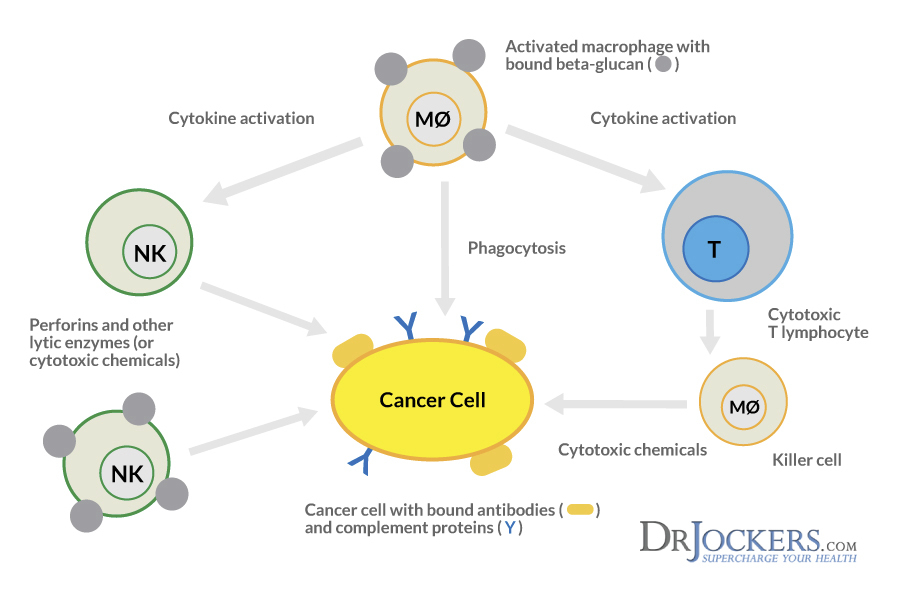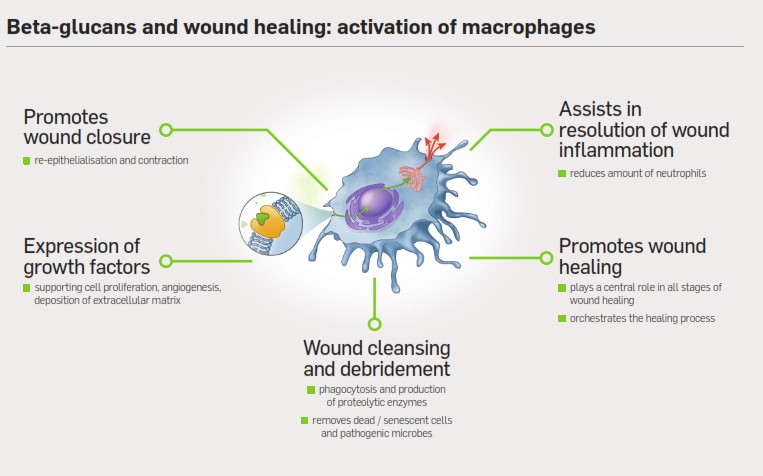Beta-ÆϾÛÌÇ Beta-Glucan
¡¡
sources: Most pathogenic fungi possess a ¦Â-glucan-rich cell wall
receptors: Dectin-1,TLR2/CR3
effects: Potent inducer of macrophage activation
¦Â-glucan-induced NF-¦ÊB translocation, stimulate the release of inflammatory mediators, including tumor necrosis factor alpha (TNF-¦Á), interleukin-1, MIP-2, eicosanoids, and reactive oxidants
Applications: infections, cancer,
¡¡
http://www.progutplus.ca/what-makes-progut-plus-different.php
¡¡
¡¡
https://www.action-inter.net/beta-1316-glucan-and-the-immune-system.html
¡¡
¡¡
https://drjockers.com/beta-glucan/
¡¡
¡¡
Compromised immune system can be re-activated
Date: November 17, 2016
Source: Radboud University
Summary:
Failure of the immune system during blood poisoning (sepsis) can be reversed by a specific sugar beta-glucan. This restores the ability of immune cells to respond effectively to infections, report researchers.
FULL STORY
Failure of the immune system during blood poisoning (sepsis) can be reversed by a specific sugar. This restores the ability of immune cells to respond effectively to infections. This week, researchers from Radboud University and Radboudumc published an article on this topic in Cell. These insights can lead to improved treatment of sepsis.
Sepsis is a life threatening complication during infections that occurs when the immune system is unable to gain control of the infection-causing microorganism. Afterwards, the immune system of many sepsis patients (30%-40%) becomes compromised. This can continue for several weeks to several months. As a result, the immune system can no longer respond to new infections, and sepsis patients have a high risk of additional complications and death due to a second infection. In an article that was published on 17 November in the journal Cell, the molecular biologist Henk Stunnenberg of Radboud University, in cooperation with internist-infectiologist Mihai Netea and other colleagues at Radboudumc, shows that this immune paralysis can be reversed. This is good news for sepsis patients, for whom treatments are currently lacking in efficiency.
In developed countries, each year approximately 2 to 30 people in every 10000 get sepsis. In the Netherlands, an estimated annual 9000 patients are admitted to the intensive care unit (ICU) with severe sepsis. Sepsis can lead to serious, permanent complications, and 20% of the sepsis patients die in the ICU.
The role of sugars
In the bloodstream, monocytes -- a type of white blood cell -- play a key role in the defense against infections. Monocytes can become macrophages, which remove harmful invaders. In 2014, the Nijmegen researchers showed that differentiation of monocytes into macrophages can be controlled by the environment. Monocytes that are exposed to a lipopolysaccharide (LPS), a molecule from the outer cell membrane of specific bacteria, mature into macrophages with a greatly reduced capacity to fend off foreign cells. This reflects sepsis-induced immunosuppression. The opposite occurs upon exposure to beta glucan, a sugar found in fungal cell walls. At the molecular level, Stunnenberg then looked at the epigenetic setting of these different types of macrophages. The epigenome is involved in regulating gene expression; it varies by cell type and person and can change due to nutrition, stress and illness. As a result, he discovered one of the "control switches" of the immune system that is driven by a sugar, beta-glucan. "By adding beta-glucan to blood samples of trial subjects with a disabled immune system, the macrophages were re-activated."Compromised immune system can be re-activated -- ScienceDaily
https://www.sciencedaily.com/releases/2016/11/161117134058.htm¡¡
Macrophage Internalization of Fungal ¦Â-Glucans Is Not Necessary for Initiation of Related Inflammatory Responses | Infection and Immunity
https://iai.asm.org/content/73/10/6340¡¡
Carbohydrate Polymers
Volume 148, 5 September 2016, Pages 61-68
Carbohydrate Polymers
The linear structure of ¦Â-glucan from baker¡¯s yeast and its activation of macrophage-like RAW264.7 cells
panelXingZhengaSiweiZouaHuiXuaQingyeLiuaJianhuiSongbMinXubXiaojuanXuaLinaZhanga
a College of Chemistry and Molecular Sciences, Wuhan University, Wuhan 430072, China
b Physics Department & The Key Laboratory of Education Ministry for Optics and Magnetic Resonance Spectroscopy, East China Normal University, Shanghai 200062, China
Received 15 January 2016, Revised 21 March 2016, Accepted 9 April 2016, Available online 12 April 2016.
Highlights
• A highly purified ¦Â-glucan (BBG) was acquired by hot water and alkali extraction.
• BBG activates macrophages to produce cytokines TNF-¦Á and MCP-1.
• BBG activates macrophages through targeting CR3/TLR2 signaling pathway.
Abstract
Yeast ¦Â-glucan has many formulations with different chemical structures, water solubility and purity. In particular, the purity of ¦Â-glucan in these formulations is variable and relatively low, contributing to different data on its biological activity. In this study, the major polysaccharide component in the crude Baker¡¯s yeast polysaccharides coded as BBG with high purity of 99% was obtained, and its chemical structure was determined to be a linear ¦Â-(1,3)-glucan. It was found that BBG interacted with complement receptor 3 (CR3) and toll-like receptor 2 (TLR2) on the surface of macrophage-like RAW264.7 cells, and initiated activation of RAW264.7 cells characterized by significant production of tumor necrosis factor-¦Á (TNF-¦Á) and monocyte chemoattractant protein 1 (MCP-1). Additionally, activation of the nuclear factor kappaB p65 (NF-¦ÊB p65), c-Jun N-terminal kinase (JNK) and extracellular signal-regulated kinase (ERK) induced by BBG, were also observed, further confirming the stimulation of RAW264.7 cells by BBG. All these findings provided important scientific evidences for better understanding the molecular mechanism of action for the linear ¦Â-(1,3)-glucan in cells.The linear structure of ¦Â-glucan from baker¡¯s yeast and its activation of macrophage-like RAW264.7 cells - ScienceDirect
https://www.sciencedirect.com/science/article/abs/pii/S0144861716304052¡¡
Ending the inflammation circle in stalled and chronic wounds by reactivation of the macrophages
So for stalled wound conditions targeting the macrophages to restore their normal functions both as ¡°housekeepers¡± and as a coordinator for the normal healing process, is an intriguing idea[4].
Tweet this: Macrophages as ¡°housekeepers¡± in #woundhealing. Curious? http://woulgan.com/how-to-avoid-stalled-wound-healing/ via @woulgan
The good news is that macrophages from elderly and diabetics are responsive to stimulation by some compounds which can restore most of their functions [5]. One such compound is soluble beta-glucan (SBG), which is a component of the topical wound gel Woulgan. By applying SBG to a stalled wound, macrophages are reactivated and become trained ¡°housekeepers¡± and coordinators of the healing process. From a practical point of view in the management of stalled wounds, this means that you don¡¯t need to know exactly what¡¯s going on at the molecular level, or which factors are out of balance. You can simply target the macrophages and train them by applying Woulgan to reactivate the whole healing process.
How to avoid stalled wound healing with the help of macrophages
https://woulgan.com/how-to-avoid-stalled-wound-healing/¡¡
¡¡
¡¡
¡¡


.jpg)

